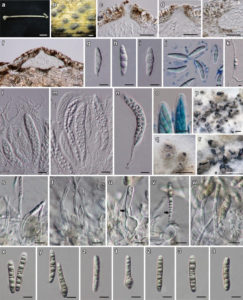Bambusicolaceae D.Q. Dai & K.D. Hyde, in Hyde et al., Fungal Divers. 63: 49 (2013).
MycoBank number: MB 804293; Index Fungorum number: IF 804293; Facesoffungi number: FoF 00586, 15 species.
Saprobic on bamboo culms, pods and palms Sexual morph: Ascomata solitary, scattered, immersed, conical, ostiolate, coriaceous. Peridium thin, composed of brown and thick-walled cells of textura angularis, with the basal part composed of thinner, hyaline cells. Hamathecium comprising relatively thin, dense, anastomosing and branching interascal filaments, usually pseudoparaphyses. Asci 8–spored, bitunicate, fissitunicate, cylindrical, with a short furcate pedicel, apically rounded, with a shallow ocular chamber. Ascospores 2–3-seriate, slightly broad fusiform, hyaline, 1-septate, narrowly rounded at both ends, surrounded by a gelatinous sheath. Asexual morph: Conidiomata small, pycnothyrial, acerous or subglobose, solitary, scattered, immersed to semi-immersed. Conidiophores indistinct. Conidiogenous cells enteroblastic, annelidic, or phialidic, discrete, cylindrical, and smooth. Conidia cylindrical and oblong to ellipsoidal, straight or slightly curved, obtuse at the apex, pale brown to dark brown, aseptate to 1–3-septate.
Type – Bambusicola D.Q. Dai & K.D. Hyde.
Notes – Bambusicolaceae was introduced to accommodate Bambusicola which consisted of three species. The morphological characters of the family are immersed to superficial, globose to subglobose ascomata, cylindrical to clavate asci and hyaline, fusiform ascospores surrounded by a gelatinous sheath. Bambusicolaceae share similar morphological characters to Tetraplosphaeriaceae (Tanaka et al. 2009). The asexual morphs are produced in culture or found on host culms. Phylogenetic analyses showed that Bambusicolaceae belongs to Pleosporales, and closely related to Massarinaceae and Montagnulaceae (Hyde et al. 2013, Tanaka et al. 2015). Three genera, Bambusicola, Leucaenicola and Palmiascoma are accommodated in Bambusicolaceae.

Fig. Bambusicola massarinia (Material examined: THAILAND, Chiang Rai Province, Doi Fung, on decaying culm of bamboo, 4 May 2011, Dong-Qin Dai DDQ0003, MFLU12-0405, holotype). a Bamboo type specimen. b Habit of immersed ascomata on host. c , d Section through ostiole with periphyses. e Section of peridium. f Section of ascoma. g–i Hyaline and 1-septate ascospores. j Ascospore with gelatinous sheath. k Germinating ascospore. l Pseudoparaphyses above asci. m Asci with ascospores. n Fissitunicate ascus. o Apices of asci. p–r Conidiomata surrounded by mycelium. s, t, w Conidiophores and conidiogenous cells producing conidia., u, v Conidiogenous cells
with 1–5 annellations. x–4 One septate conidia. Scale bars: a =50mm, b, p–r =100μm, c–f =50μm, g–k, s–4 =5μm, l–o =10μm
